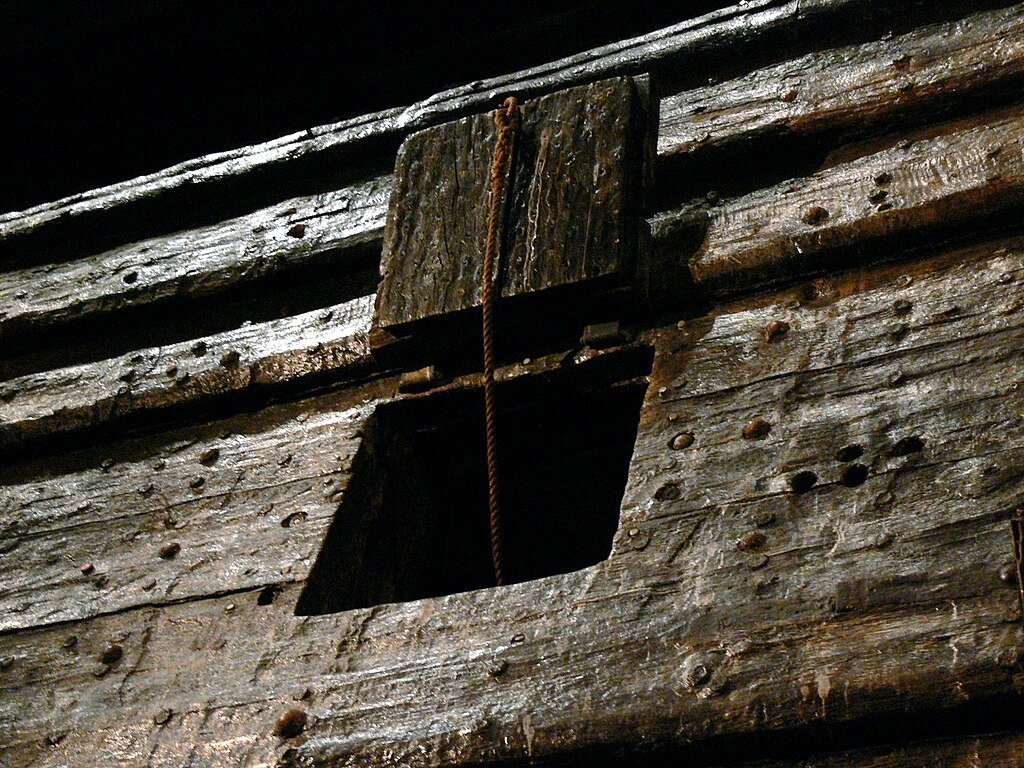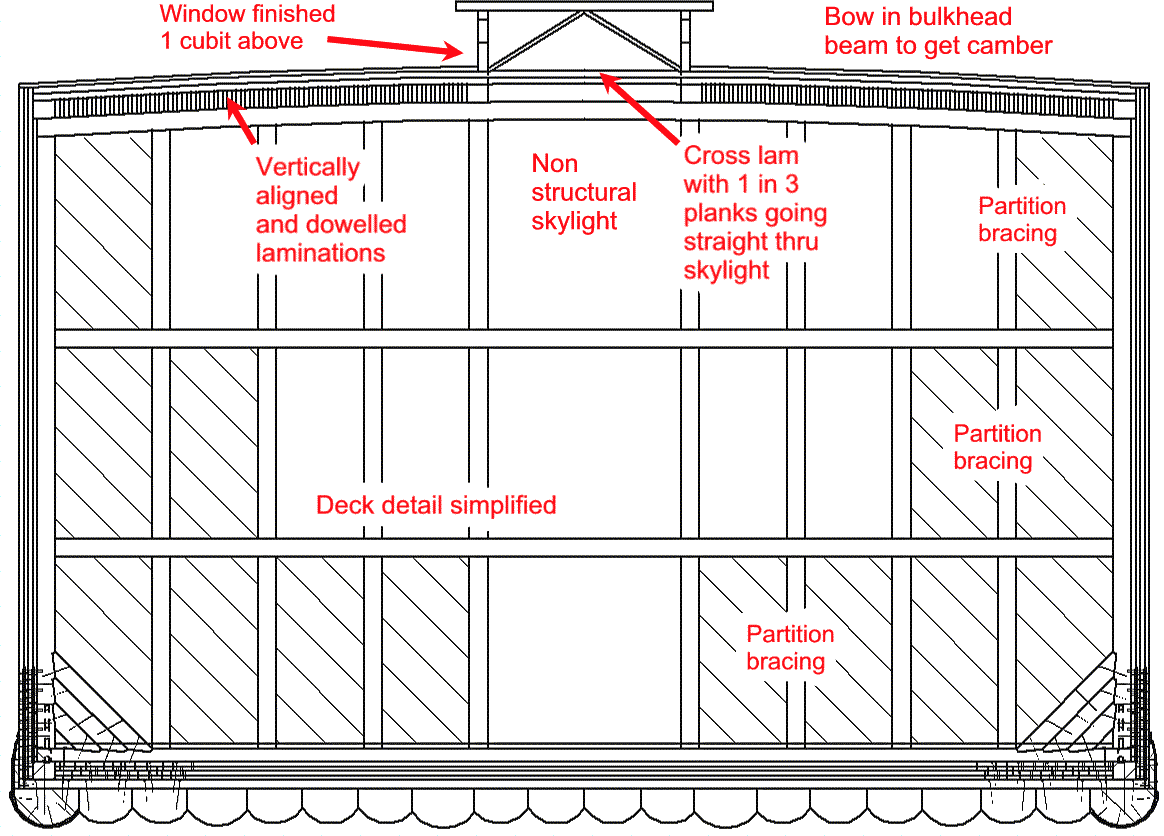
How Could the Ark Have Survived the Stresses of the Flood?
An in-depth examination of transverse sectional components of Noah’s ark feasibility
The keel of the ark had to survive an unusual launching. During the rise of the floodwaters, the ark was probably buffeted by earthquakes, particularly in a catastrophic plate tectonic scenario. This was something it should have handled, provided it didn’t end up sliding down a hill or rattling around on a rock. Next, it was lifted by the flood, a dangerous situation if there was a fair current. Worse still, it was beached during a global wind, which was almost certainly a sea with waves, even on the lee side of an island. It had to remain intact during the beaching too, or else the animals would be stuck in the mud.
Our solution is to add a generous false keel, with keel logs (750) + transverse beams (200) + longitudinal planking (400) + framing (400) + decking (100), giving nearly 2 m from the bottom to the lowest deck level. If the measurement of 30-cubit height is taken from the lowest extremity, we could lose 3 to 4 m when the roof is included. That’s almost an entire deck.
The Overall Size
The first simple question is: Do the measurements refer to capacity (interior volume) or the external envelope of the ark?
Until this question has been answered, the external membrane will be taken as the datum indicating the limit of the ark, since everything outside this is “wet” and inboard of this it should be “dry.” This is an intermediate position between the extremes of inside and outside dimensioning.
For a structural defense of the ark, we should not only assume the largest likely cubit to be taken but also assume that the dimensions of 300 x 50 x 30 cubits define the internal volume. This would be the largest possible ark, which is the worst case from an engineering perspective. The opposite is true for the space argument where a small ark is the conservative choice.
The Roof
A closed tube is many times stronger than an unjoined tube. Consider a cardboard toilet roll tube—as soon as a lengthwise cut is made the cylinder is very weak and has lost almost all torsional resistance. That slice down the length of a toilet roll tube is like the slicing of the ark roof by the full-length window opening. It destroys the monocoque advantage.
In a 30 mm diameter tube of 1 mm wall thickness, the joined cylinder is 631 times stiffer in torsion!1
Relative thinness of the tube exaggerates the effect, but this round tube is proportionally thicker than the ark monocoque. With a rectangular section, the ark will be less sensitive, however, perhaps only a few hundred times softer. Internal frames and bulkheads will help, but we certainly must keep that roof skin together.
Transverse Section: Concept 1.
The basic concepts of the transverse cross section are shown below.
Curvature: The top beam is curved over the longer inboard posts prior to frame erection. Possibly laminated to reduce the curvature of the bottom beam of the frame assembly, although this could be restrained by some temporary bracing. Curvature should also have a strengthening effect.
Vertical Laminations: A fresh approach to plank lamination is used in the roof. In order to span the main frames, the planks are laid edgewise (vertical). This would normally make attachment to the frame difficult, but in the roof, the requirements are less severe. The superimposed cross laminations also tie the roof down. Skew nailed spikes could also be added to fix the roof and frame together.
Cross-laminations: The trick is to extend SOME of the cross-laminations right through the skylight area, effectively preventing any shear at the window zone. Perhaps one in three planks would suffice (calculations will tell). The effect would be a diagonal lattice spanning the skylight area. It would also be possible to reduce the number of through planks toward the ends of the hull where loads should be reduced, simply by skipping three or four planks at a time.
Skylight Structure: The raised skylight structure is nonstructural. (It does not add strength to the hull). So the only requirements are wind loads and the risk of a freak wave perhaps. A generous (1 cubit) wall is added below the window to arrest roof water that is headed inboard. A pitched roof on the skylight seems hardly necessary on a ship. The smaller skylight could also lend itself to a relatively easy water collection by sloping the roof in a V shape. There would need to be baffles along its length to keep it there for a little while as it drains into tanks onboard.
Windows
A window shalt thou make to the ark, and in a cubit shalt thou finish it above. (Genesis 6:16 KJV)
Make a roof for the ark, and finish it to a cubit above. (Genesis 6:16 ESV)
So the Hebrew tsōhăr may be used to refer to the function of the window as a skylight, and if it was in the center of the ark’s roof, the most light would enter at midday.
The Hebrew word צֹהַר (tsōhăr) is not the usual word for window; in fact, this word appears only here in the Old Testament. The related word צֹהָֽרָֽיִם (tsŏhŏrā’yim) is translated as noon or midday.2 So the Hebrew tsōhăr may be used to refer to the function of the window as a skylight, and if it was in the center of the ark’s roof, the most light would enter at midday.
Some translations opt to interpret tsōhăr as roof, but again, there is a more common word for roof. Rather, tsōhăr may refer to a pitched or vaulted roof, which would obviously be better suited for the conditions it would encounter in the flood.3
Ridge ventilation is logical. Modern factories utilize a ridge opening to allow rising warm air to escape. A central opening is an appropriate location for ventilation in the ark, assuming, of course, that the tsōhăr was (preferably) not glazed. Whether the tsōhăr was predominantly for light or ventilation is perhaps not possible to determine conclusively, but it is easy to imagine that God knew a light opening would ventilate successfully.
“Finish it to a cubit above.” (Genesis 6:16)
This is most often interpreted to mean a continuous slotted “cubit-tall window” (ref 1, p. 38). Woodmorappe hints at a perimeter location (ref. 1, fig. 5, p. 38), but the Korean researchers (ref. 2) kept the window away from the side of the vessel (reducing the chance of collecting deflected wave spray and green water on a big roll. In fact, their design limit was set as the dipping of this corner into the water, so a perimeter window was not a good idea). There is a problem here. It is raining, and there are waves rocking the vessel. Even a generous pitch of the roof will not prevent water from cascading in through the window. A far worse situation occurs when the ark meets a crosswind and rolls to lee side. The roof facing the wind is now at least level, if not reversed, and the wind is helping to send it straight inside.
Morris (ref. 3, p. 182) gives another possibility. “It has also been suggested that the word ‘window’ might refer to a low wall extending around the Ark above the roof, providing a sort of cistern as a means of water supply.” For collecting water, there may be some merit if the sloshing water can be stilled somehow. What is interesting is that the idea probably stems from the Hebrew “from above.”
Here is another interpretation. Make the bottom of the window one cubit above the roof. Now the window finishes to a cubit from above the roof. “You shall make a window for the ark, and you shall finish it to a cubit from above” (Genesis 6:16 NKJV). Hence a wall works better than a sloped roof because it would take some time to fill, by which stage the ark has rolled back again and dumped the water overboard. This is the normal way to build a skylight on a ship. The “wall” is called hatch combing. A camber on the roof similar to the deck of a modern ship should suffice.
Hatches?
In timber ships, the gun ports, especially the lowest ones, were sealed by hinged doors. Note the thickness and small size. Sealing was not very sophisticated, and a little water getting in during a storm would be the least of their worries. Note the ropes to open and close the door.

Gunport of timber ship. Wolfgang Sauber, CC BY-SA 3.0, via Wikimedia Commons.
Whether the light (tsōhăr) windows needed hatches might be questionable. It depends on the sea state. If doors like these were employed on the roof, the ark would be nearly bombproof. The high pressures of wave-slamming loads at the lowest gunports (almost on the water level) are unlikely to be found on the top of the ark, but worst-case scenario, rogue wave loadings might dictate a relatively robust construction. The question to be addressed is whether green water (actual waves) will make it to the roof, rather than simply foam, spray, and rain.

References
1. John Woodmorappe. 1994. Noah’s Ark. A Feasibility Study. El Cajon, CA: Institute for Creation Research.
2. D. Gon, B. Hyun, and S. Hong, 1994. “Safety Investigation of Noah’s Ark in a Seaway.” Creation 8, no. 1 (April): 26–35. https://answersingenesis.org/noahs-ark/safety-investigation-of-noahs-ark-in-a-seaway.
3. Henry Morris. 1976. The Genesis Record. Grand Rapids, MI: Baker Book House.
4. Alfred Dudszus and Ernest Henriot. 1986. Dictionary of Ship Types: Ships Boats and Rafts Under Oar and Sail. London: Conway Maritime Press. English edition of Das Schiffstypen Lexikon Transpress VEB Verlag fur Verkehrswesen. 1983.
Answers in Depth
2024 Volume 19
Answers in Depth explores the biblical worldview in addressing modern scientific research, history, current events, popular media, theology, and much more.
Browse VolumeFootnotes
- A closed cylinder, where do = 30; di = 28; r = 14.5; t = 1, has a polar moment of inertia given by J = π (do4 – di4) / 32; whereas an open cylinder (slitted) gives J = 2 (π r t3) / 3.
- Genesis 43:16, 25; Deuteronomy 28:29; 2 Samuel 4:5; 1 Kings 18:26, 27, 29; 20:16; 2 Kings 4:20; Job 5:14, 11:17; Psalm 37:6, 55:17, 91:6; Song of Solomon 1:7; Isaiah 16:3, 58:10, 59:10; Jeremiah 6:4, 15:8, 20:16; Amos 8:9; Zephaniah 2:4.
- Hamilton, Victor P, The Book of Genesis, Chapters 1–17, The New International Commentary on the Old Testament, (Grand Rapids, MI: Eerdmans, 1990), 283.

Answers in Genesis is an apologetics ministry, dedicated to helping Christians defend their faith and proclaim the good news of Jesus Christ.
- Customer Service 800.778.3390
- © 2024 Answers in Genesis

